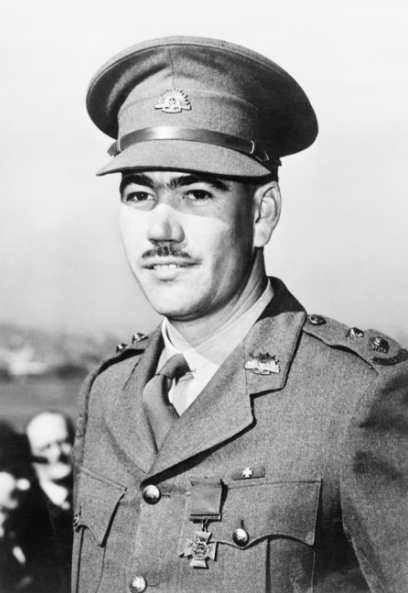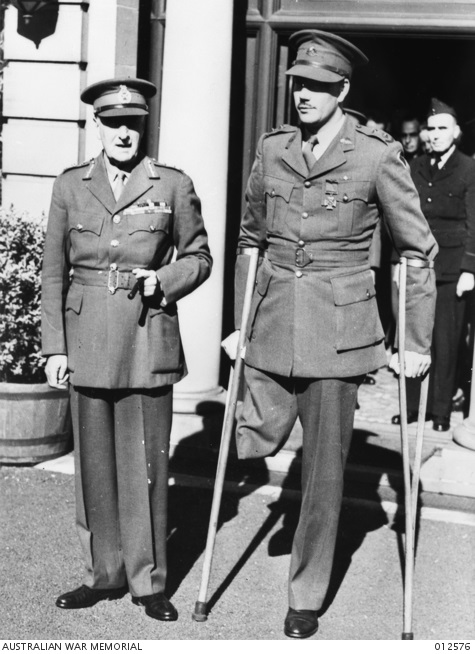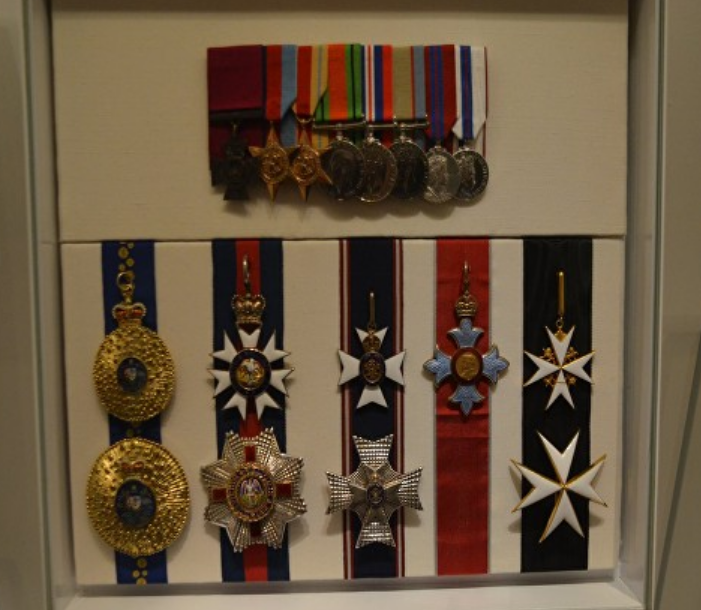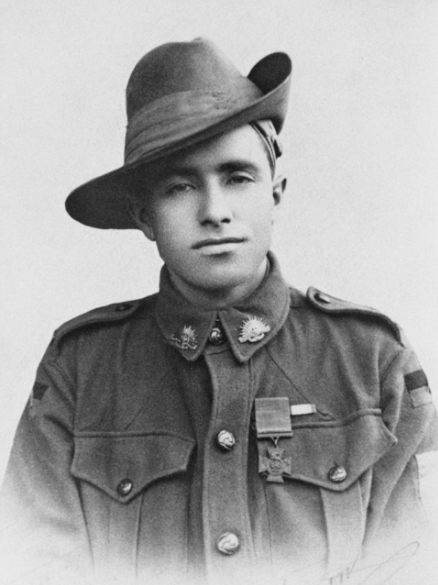Sir Arthur Roden Cutler VC, AK, KCMG, KCVO, CBE (1916 - 2002, 85yo)
 Arthur Roden Cutler was born on 24 May 1916 and raised in Manly, New South Wales. Following his education, he secured employment with the Texas Company Australasia (Texaco) while pursuing evening economics studies. His military service began in 1936 with the Sydney University Regiment. Lieutenant commission in the Militia followed on 10 November 1939, with May 1940 transfer to the Second Australian Imperial Force bringing commission with the 2/5th Field Regiment of the 7th Divisional Artillery.
Arthur Roden Cutler was born on 24 May 1916 and raised in Manly, New South Wales. Following his education, he secured employment with the Texas Company Australasia (Texaco) while pursuing evening economics studies. His military service began in 1936 with the Sydney University Regiment. Lieutenant commission in the Militia followed on 10 November 1939, with May 1940 transfer to the Second Australian Imperial Force bringing commission with the 2/5th Field Regiment of the 7th Divisional Artillery.
His unit departed Australia for the Middle East on 20 October 1940. During the Australian Infantry assault on French positions at Merdjayoun on 19 June 1941, Cutler served with an artillery forward observation team assigned to the 2/25th Battalion. The infantry advance stalled following severe casualties from an enemy tank-supported counter-offensive. Despite machine gun fire sweeping the area, Lieutenant Cutler, accompanied by another artillery officer and small detachment, advanced beyond the infantry to establish a forward position in a building. When communications failed, Cutler ventured out under machine gun fire to repair the telephone connection before returning to the structure, from which enemy installations and artillery were successfully targeted. Enemy forces then assaulted this position with combined infantry and armoured units, eliminating the Bren gunner and fatally wounding the accompanying officer. Lieutenant Cutler and one remaining soldier operated the anti-tank rifle and Bren gun in defence, repelling the infantry assault. Though tanks maintained their attack, sustained fire from the anti-tank rifle and Bren gun ultimately forced their withdrawal. Lieutenant Cutler personally directed the wounded evacuation before advocating continued advance. His orders required establishing a position for monitoring the sole road permitting enemy transport access to the settlement. Leading volunteer personnel, he advanced until successfully positioning himself and one companion directly within the Foreign Legion-occupied town, despite machine gun fire preventing infantry progress. Lieutenant Cutler recognised enemy concentration on his left flank for counter-attack and his isolation risk. Nevertheless, he completed his road registration mission and engaged enemy positions. The enemy counter-offensive with infantry and tanks severed his connection to friendly forces, compelling him to seek cover before successfully navigating enemy lines after nightfall. His road registration work proved crucial to the enemy’s eventual withdrawal.
During 23 - 24 June 1941, Cutler commanded a 25-pounder positioned within friendly forward defensive areas to neutralise enemy anti-tank weaponry and installations. Mission completion enabled Merdjayoun’s recapture the following morning.

Subsequently at Damour on 6 July 1941, when advancing infantry faced suppression from concentrated hostile machine gun fire, Cutler disregarded personal safety to establish communications with his forward position, sustaining severe wounds in the process. Twenty-six hours passed before rescue became feasible, during which time his injuries developed infection requiring leg amputation.
Cutler’s Merdjayoun performance demonstrated exceptional military valour, and his conduct throughout 18 days of combat, concluding with his wounding and subsequent amputation, earned him the Victoria Cross. Medical repatriation followed, with the Governor General of Australia, Lord Gowrie, presenting him the Victoria Cross on 11 June 1942 while he stood supported by crutches.
Post-war years launched his extensive Australian diplomatic career. His High Commissioner appointment to New Zealand spanned 1946 - 1952, followed by Sri Lankan service from 1952 - 1955, then Australian Minister duties in Egypt during 1956. January 1957 brought his role as Secretary-General of the South-East Asia Council of Ministers, with 1957 - 1958 service as Chief of Protocol for the Department of External Affairs. The RSL State Presidency occupied him in 1958. Pakistani High Commissioner responsibilities extended from 1958 - 1961, succeeded by Australian Consul-General duties in New York from 1961 - 1965, during which he represented Australia at United Nations General Assembly sessions in 1962, 1963 and 1964. His concluding diplomatic assignment began in 1965 as Ambassador to the Netherlands, though this ended prematurely in 1966 upon his return as Governor of New South Wales, a position he maintained for an unprecedented 15 years.

Cutler received appointment as Commander of the Order of the British Empire (CBE) in 1957. Recognition of his diplomatic contributions to Australia brought The Queen’s honour as Knight Commander of the Order of St Michael and St George (KCMG) in 1965. Additional recognition followed with Knight Commander of the Royal Victorian Order (KVCO) in 1970, and 1981 brought his appointment as Knight of the Order of Australia (AK).
Cutler died on 22 February 2002 after an extended illness. The New South Wales Government bestowed the exceptional honour of a state funeral on 28 February 2002.
Private Henry (Harry) Dalziel, VC (1893 - 1965, 72yo)
 Henry Dalziel was born on 18 February 1893 at Irvinebank, Queensland. His local education preceded employment as a fireman on the Cairns-Atherton railway. Dalziel enlisted as a private with the Australian Imperial Force on 16 January 1915 and departed with reinforcements destined for the 15th Battalion.
Henry Dalziel was born on 18 February 1893 at Irvinebank, Queensland. His local education preceded employment as a fireman on the Cairns-Atherton railway. Dalziel enlisted as a private with the Australian Imperial Force on 16 January 1915 and departed with reinforcements destined for the 15th Battalion.
Dalziel reached his unit at Gallipoli in July, participating in the Sari Bair engagement before evacuation with his battalion to Egypt. His 1916 French deployment brought front-line service at Bois Grenier plus operations at the Somme, Pozières and Mouquet Farm. Combat in 1917 included Gueudecourt, Lagnicourt, Bullecourt and Messines prior to shrapnel wounds at Polygon Wood on 16 October 1917. Duty resumption occurred on 7 June 1918, initially as a driver before becoming a gunner.
Throughout the Battle of Hamel, his battalion’s progress encountered determined opposition from a well-equipped enemy force at Pear Trench. Dalziel, serving as second operator of a Lewis-gun team, assisted his partner in neutralising machine-gun fire. When additional fire emerged from another position, he charged forward and used his revolver to eliminate or capture the crew and weapon, enabling continued advance. This engagement cost him his trigger-fingertip; though ordered rearward, he maintained gun operation during Pear Trench’s final assault. Despite renewed orders for medical attention, he began ammunition resupply to forward positions, continuing until head wounds ended his participation. His actions earned him recognition as the 1000th VC recipient on 4 July.
Dalziel’s injuries proved so extensive that his skull fractured and brain became exposed. Against expectations, he survived and underwent comprehensive English medical care before January 1919 Australian return. His homeward train journey featured hero’s receptions at every station from Townsville to Atherton. He lived an additional 47 years before succumbing to stroke on 24 July 1965 at the Repatriation General Hospital, Greenslopes, Brisbane, receiving cremation with military honours.
Last Reviewed 06/2025









